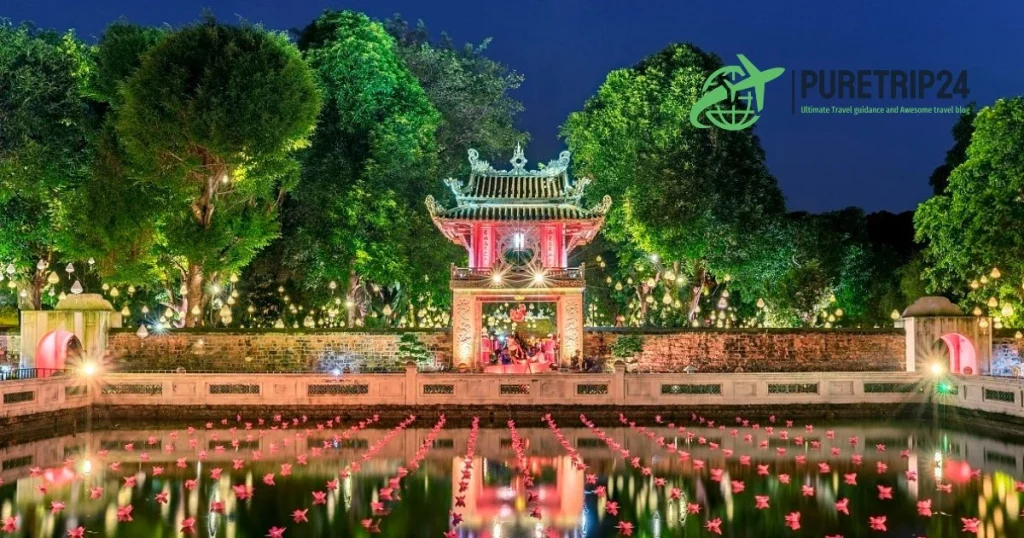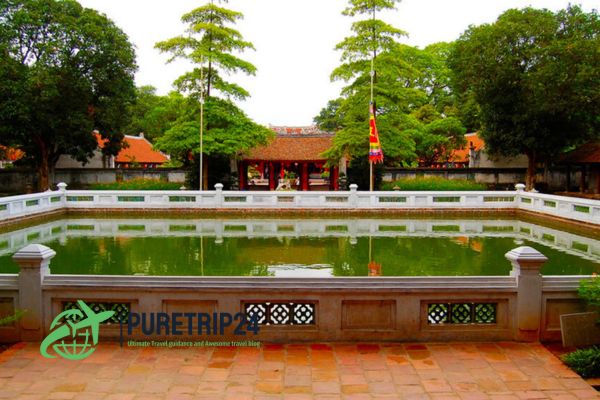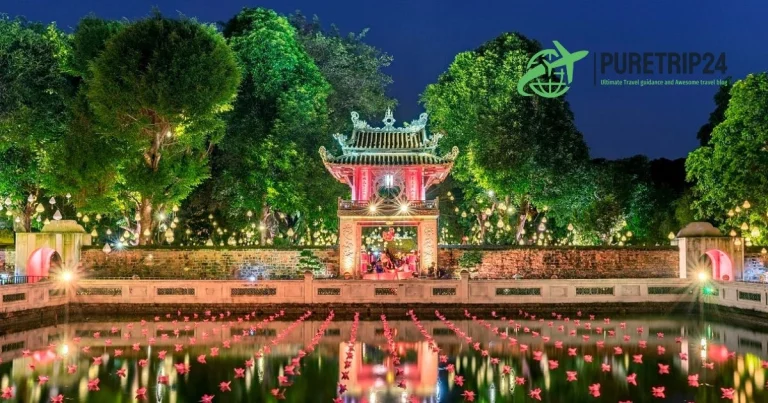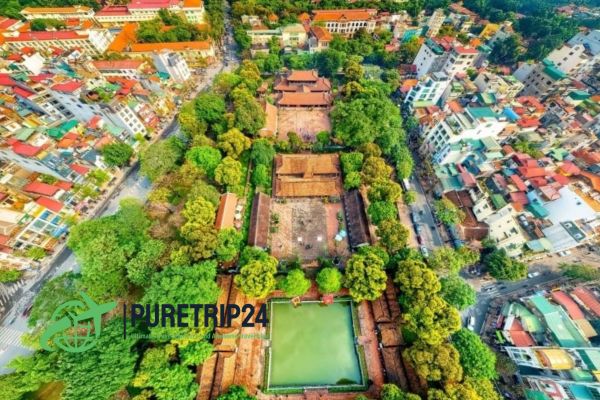As of today, the Temple of Literature represents the universal appreciation of the Vietnamese people towards learning and education which is itself a place of attraction to numerous visitors who come for the beautiful architecture, the past and its importance in the present society.

Fine architectural works of the Temple of Literature
Temple of Literature is one of the best and upstanding representatives of the traditional Vietnamese architecture showing a very good combination of natural features and artificial features. The entire set of buildings is arranged into five courtyards which are all different and important in various ways.
The First Courtyard: The Entrance
The first courtyard, as you enter the great compound of the Temple of Literature, is taken aback by the majestic Great Gate, or the Gate of Great Unity, which is decorated with a plethora of carvings and symbolic designs. It indicates the end of a busy city and the dosage of tranquility within the walls instead. However upon crossing the first courtyard, the sounds of Hanoi are no more to be heard but the soothing sounds of the temple.
The Second Courtyard: The Path of Scholars
The other notable structure is a wooden pavilion built on the East axis of the great temple of Literature called Khue Van Cac (Pavilion of the constellation of Literature). It is surrounded with beautiful yards and paths that lead to the first courtyard Papua. With its aesthetically pleasing circular glasses and nicely shaped top, this red wooden pavilion is one of the most photographed structures in the temple. This pavilion was built in the year 1805 and it signifies literature and education as it poses as a learning beacon.
The Third Courtyard: The Well of Heavenly Clarity

In the third courtyard, one can find the Well of Heavenly Clarity (Thiên Quang Tỉnh), an elongated water basin that resembles a lake framed by trees and buildings. This particular part of the structure is quiet and serene almost offering one a resting area for contemplation. Stretched across the opposite ends of the courtyard are the very popular Stelae of Doctors. These were stone tablets that were engraved with the names of students/ scholars who had qualified for the imperial examinations and other honors received by the acclaim. These stelae are displayed on the backs of stone turtles that are considered symbols of longevity and wisdom.
The Fourth Courtyard: The House of Ceremonies
The fourth courtyard gives way to the House of Ceremonies (Đại Bái Đường) and Sanctuary (Thượng Điện). In earlier days, the House of Ceremonies was a ceremonial structure, where essential ceremonies and other scholastic practices took place. Inside, one may find various altars for Confucius below which are kept offerings and incense, or to one of his four most important disciples. Here again is the most pronounced feeling of Confucianism, in this case, being the dignity of the space and reverence it is designed to elicit from the visitors.
The Fifth Courtyard: The Imperial Academy
As for the fifth and last courtyard, the present inhabitants of the temple added the Imperial Academy (Quốc Tử Giám) which was completed by the year 1076. This is the Nguyen dynasty’s first university where students studied the Chinese Classics literature and the Confucian way of governance. The academy has a classroom block, a hostel for the students, and effigies of great scholars. While the university ceased to operate, the Imperial Academy continues to symbolize the importance of education in Vietnam.
Why the Temple of Literature Should Be Visited in Hanoi, Vietnam
The Temple of Literature is not only a tourist attraction or a monument of historical interest but a centre of education and culture of the people of Vietnam. It has been a place for ages where scholars both old and young have come to look for information. Even in this modern era, Vietnamese school children visit the temple to worship and seek blessings for their exams. Therefore, an education link to the site makes Temple of Literature a very relevant place to visit.
2.Bundle Of Architectural Work
The temple features a trademark Vietnamese architecture that is pleasing to the eye due to its unique combination of nature and human design. The use of stone, wood and water in the entire complex helps to create balance and is conducive for calmness and self-quieting. From grand entry arches to still water gardens and tabernacle patterns, each part of the temple is exquisite.
3.Graphic Opportunities
For photographers, The Temple of Literature has many interesting enticing angles which highlight its beauty. The Khue Van Cac Pavilion is very popular as a photo point as the evening Sun rays shine on it during the golden hour. The gardens with their lavish profusion of foliage, the beautiful old trees and placid ponds make some lovely frames. l Tips for A Trip to the Temple of Literature
Optimal Visit Period

The tranquility of Temple of Literature is best experienced by those who go in the early hours or late in the afternoon. This timing avoids the high number of visitors and helps one to circumnavigate the place without a hassle and embrace the serenity. While the Temple of Literature is a sight of attraction, weekends and public holidays should be avoided as the crowds can be large.
Fee Structure and Opening Hours
The opening hours of the Temple of Literature are from eight a.m. to five p.m. all days. The entrance fee is roughly thirty thousand dongs which is close to 1.3 dollars in monetary terms, and this assists in site upkeep and preservation of the ancient materials and culture.
Guided Tours
If you want to explore and understand more about the Temple of Literature, you can choose to participate in a guide led tour. Countless local tour companies provide tours around the temple which explain the history of the temple, its culture and heritage, and provide some interesting stories. These tours are usually multilingual, hence reducing the barriers of communication for foreign tourists regarding the site.
How to Get There
The temple is situated in central Hanoi so it is in sight of any transportation. If you are staying in the Old Quarter for example, then it takes only a fool’s taxi or Moto Bike ride. Otherwise, you can do some walking if you are feeling active. The address of the temple is 58 Quốc Tử Giám, Văn Miếu, Đống Đa, Hà Nội.
Conclusion
Visiting the Temple of Literature is indeed travelling through the rich historical, cultural and educational backgrounds of Vietnam. The traveler the experiences the structural beauty and artistic creativity or is seeking an organic insight about the place, has a reason to visit this temple. While admiring these ancient structures, the tourist will also learn to appreciate the philosophy of relation with responsibility which has been deeply entrenched in Vietnam for centuries.
If you read more articles on puretrip24.com, you will find out more tips, guides, and information about traveling in Vietnam and other countries. Happy traveling


